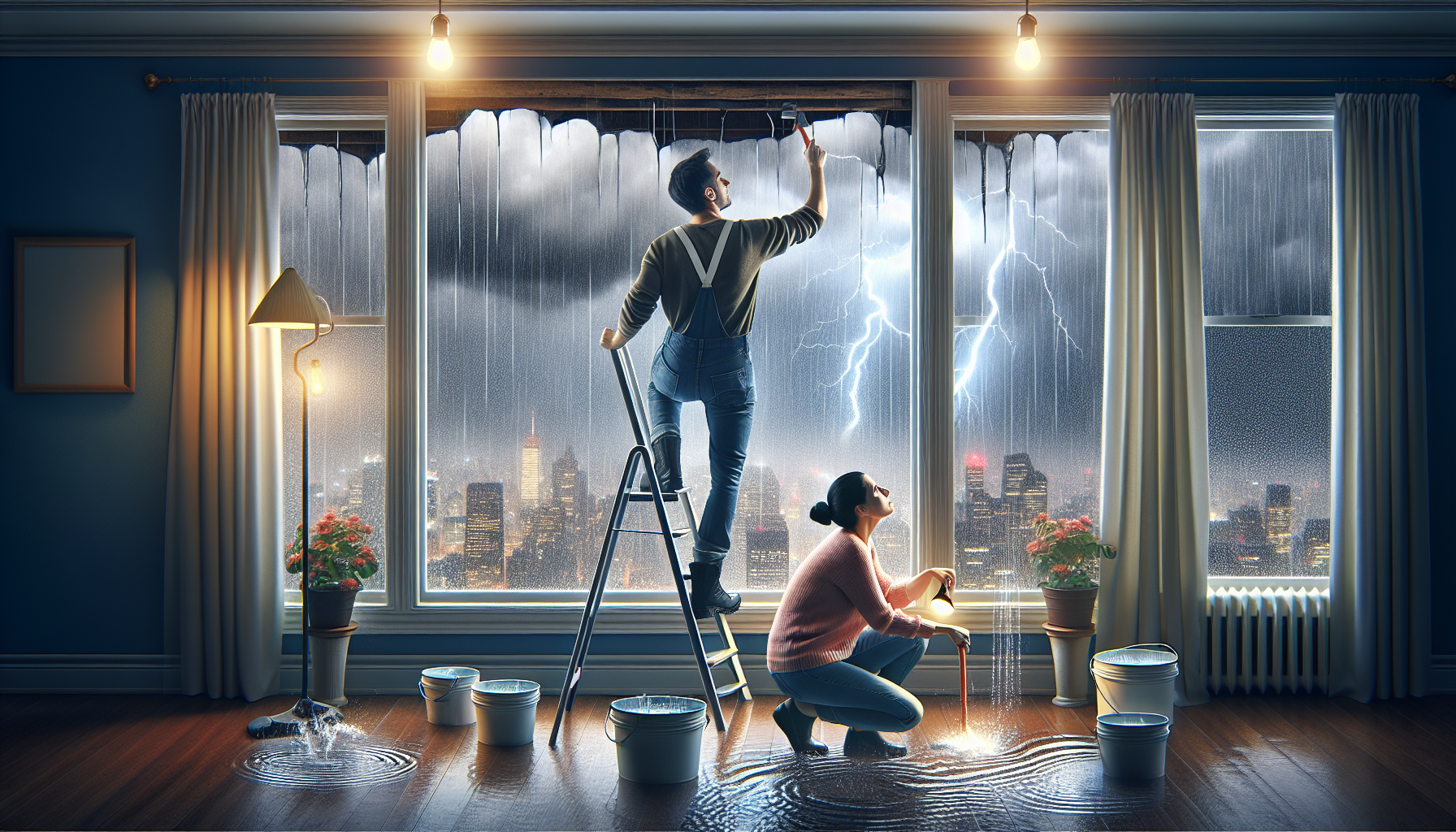This article will explore the signs of a roof leak, common causes of roof leaks during storms, and effective methods for emergency roof leak repair. It will provide readers with comprehensive steps to take during a storm to mitigate damage, as well as what actions to follow once the storm has passed to ensure a thorough roof inspection and repair. Additionally, navigating insurance claims related to roof leak repairs and understanding coverage can be complex, but it is crucial for securing the necessary funds for repairs. From skylights and ceiling leaks to emergency roof leak repair near me, we will cover the essentials of managing a roof leak emergency during stormy weather, aiming to give homeowners peace of mind and a clear path to recovery.
Identifying Common Causes of Roof Leaks During Storms
Broken Shingles
Roof leaks during storms are often caused by broken or missing shingles. High winds can lift shingles from the roof deck, leaving the underlayment exposed and vulnerable to water intrusion [1]. Additionally, shingles may be creased or lifted due to wind damage, creating pathways for water to enter the home [2] [3]. Homeowners should regularly inspect their roofs for these signs of damage, especially after severe weather events.
Flashing Vulnerabilities
Flashing is critical in preventing water from seeping into places where the roof meets vertical structures like chimneys and skylights. However, flashing can fail due to several reasons, including corrosion, improper installation, or physical damage from storms [4] [5] [6]. When flashing is compromised, water can easily penetrate these vulnerable junctions during heavy rain, leading to leaks that damage the interior of the home.
Aging Roof Components
Over time, roofing materials deteriorate. This natural wear and tear can lead to leaks, especially during heavy rain. Common aging signs include rusting or corrosion of metal components, cracks in tiles or shingles, and the breakdown of sealants used around roof penetrations [4] [7]. Regular inspections can help identify these issues early, before they lead to significant water damage during storms.
To ensure the integrity of your roof and prevent leaks, it’s crucial to address these issues promptly. Consider scheduling a professional inspection and repair service with Roof Revivers to maintain your roof’s condition and enhance its longevity.
Steps to Take During a Storm
Clear the Area to Prevent Further Damage
During a storm, it is crucial to prevent further damage by moving electronics, furniture, and other valuables away from the area where the roof is leaking. If the leak is near electronics, quickly relocating them can prevent the risk of an electrical fire [8]. Covering items with plastic sheeting can also protect them from water damage [8].
Utilize Tarps and Plastic Sheeting
To protect the affected area from further water intrusion, securing a tarp over the damaged section of the roof is essential. Select a tarp that extends at least 3 feet beyond the leak in all directions to ensure adequate coverage [9][10][11]. It is important to ensure the tarp is secured properly to prevent it from being blown away by strong winds. Using sandbags or creating an anchor board can help keep the tarp in place [12].
Catch Dripping Water with Containers
Placing containers such as buckets or pots under leaks can catch dripping water and minimize damage to floors and belongings. It is important to empty these containers regularly to prevent overflow [8][9][13]. While this is a temporary solution, it helps manage the situation until professional repairs can be made.
To ensure the safety and integrity of your home, consider scheduling a professional inspection and repair service with Roof Revivers. Their expertise can help address any issues promptly, reducing the risk of further damage and ensuring peace of mind during stormy weather.
Post-Storm Actions
Document All Damage Thoroughly
After a storm, it is crucial to document all damage to your roof comprehensively. Homeowners should capture high-quality images and videos, including wide shots of the entire roof and close-ups of specific damages. Detailed notes describing each damage, its location, and possible causes are essential. This documentation will be invaluable in supporting insurance claims and facilitating repairs [14].
Contact a Professional for Inspection and Repair
Attempting to inspect or repair the roof yourself can be dangerous and may lead to further damage or personal injury. It is advisable to contact a professional roofing contractor who is equipped to identify and repair damages effectively. Professional roofers will conduct a detailed inspection, including assessing the roof’s stability and checking for hidden damages like small leaks or structural issues, ensuring that no damage is overlooked [15]. They will also provide a detailed roof report, which is necessary for insurance claims and future reference [16].
Assess the Need for Long-Term Preventive Measures
Consider long-term preventive measures to enhance your roof’s durability against future storms. This includes ensuring that the roof is installed correctly with high-quality materials and considering professional waterproofing treatments. Regular maintenance, such as trimming trees to prevent damage and cleaning gutters to avoid water pooling, is also crucial [17]. These measures will help mitigate the risk of future roof leaks and extend the lifespan of your roof.
To ensure the safety and integrity of your roof, scheduling a professional inspection and repair service with Roof Revivers is recommended. Their expertise can help address any issues promptly, reducing the risk of further damage and ensuring peace of mind during stormy weather.
Navigating Insurance Claims and Coverage
Understand Your Policy
It’s vital for homeowners to thoroughly understand their insurance policy to effectively navigate claims for roof repairs. Different policies offer varying levels of coverage, and knowing the specifics can significantly impact the financial assistance received. For instance, an Actual Cash Value policy provides the depreciated value of the roof, whereas a Replacement Cost Value policy covers the cost to replace the roof entirely, though not all funds are provided upfront [18].
Take Clear Photos and Videos of Damage
Documenting damage is crucial in the claims process. Homeowners should take clear photos and videos of all roof damage and any related interior damage. This visual evidence should be detailed, showing the extent of damage and, if possible, include images of the roof prior to the damage to establish its recent occurrence. Such documentation supports the claim and aids in the swift processing and approval by insurance adjusters [19].
Communicate with Insurance Representatives
Effective communication with insurance representatives can expedite the claims process. Homeowners should maintain detailed records of all interactions with their insurance company, including dates, the specifics of conversations, and any agreements made. Sending summaries of important conversations via email can provide a record that may be crucial in case of disputes. Additionally, being cooperative, timely, and organized when providing required documents and information can increase the likelihood of claim approval [20].
To ensure the integrity of your roof and expedite any necessary repairs, consider scheduling a professional inspection with Roof Revivers. Their expertise can help address any issues promptly and efficiently, providing peace of mind and aiding in the smooth handling of insurance claims.
Conclusion
Throughout the endeavor to secure our homes against the inevitable wear and degrade bestowed by tempests, the crux of our narrative has illuminated the spectrum from early detection of roof leaks to the exhaustive post-storm recuperation processes, underscoring the pivotal role of prompt action and the essence of professional intervention. We’ve ventured through the delineation of preemptive measuring, such as regular inspections and maintenance, and navigated the labyrinth of insurance claims, all aimed at fortifying the sanctuary we call home. The narrative eloquently encapsulates the journey from mitigation to restoration, reminding us of our abode’s vulnerability to nature’s whims and the quintessential necessity of readiness and resilience.
Encapsulating the expertise shared, it beckons us to reflect on the preservation of our homes as not just a task but an ongoing commitment to safeguarding our comfort, safety, and peace of mind against the tempests that loom. Implicit in our discourse is an invitation to action, a prompt to not merely react but to proactively engage with professionals who comprehend the breadth and depth of storm-induced adversities. In this light, the recommendation to contact Roof Revivers for a FREE inspection and get your leak repaired is not just advice; it is a clarion call to embrace diligence in the custody of our shelters, ensuring that when the storm clouds gather, our defenses are as impregnable as our spirits.
FAQs
1. What should I do if my roof starts leaking during a storm?
Immediately take action to manage the situation by placing a bucket or other container beneath the leak to catch the water. If it’s safe to do so, puncture any bulging water spots on your ceiling to release trapped water and prevent the ceiling from collapsing. Additionally, move any furniture, electronics, and valuables away from the leak to protect them from water damage.
2. How quickly can a leaking roof cause damage?
It is difficult to specify an exact timeframe for when a roof leak will cause damage as many factors influence this. However, it is crucial to address a roof leak promptly to avoid potential damage. Delaying repairs can lead to more significant issues, so it’s advisable to fix leaks as soon as they are discovered.
3. Is a roof leak considered an emergency?
The severity of a roof leak determines whether it’s an emergency. If water is actively pouring into your home, it constitutes an emergency that requires immediate attention. Conversely, a minor damp spot or a water stain is less urgent, though it should not be ignored. A leaking roof will continue to deteriorate if left unattended.
4. How can I patch a roof temporarily in an emergency?
For a temporary fix during an emergency, you might use plastic sheeting or tarps. If these are insufficient, a more thorough DIY patch using tar paper and roof felt may be necessary. Keep plastic roofing cement on hand for such emergencies. Apply this cement to the tar paper using a trowel, putty knife, or caulk gun to seal the patch effectively.
References
[1] – https://www.owenscorning.com/en-us/roofing/blog/signs-of-storm-damage
[2] – https://www.youtube.com/watch?v=oWfVEz554WE
[3] – https://www.billraganroofing.com/blog/signs-storm-damage-roof
[4] – https://www.americanwayexteriors.com/blog/expert-tips-to-identify-and-prevent-roof-flashing-leaks
[5] – https://www.negutters.com/blog/roofing/roof-flashing-failure-why-it-occurs-and-ways-to-address-it/
[6] – https://www.northpointroofingsystems.com/signs-of-damaged-flashing
[7] – https://newviewroofing.com/blog/roofing/warning-signs-of-an-aging-and-failing-roof/
[8] – https://www.stormguardrc.com/resources/what-to-do-if-your-roof-leaks-during-a-storm/
[9] – https://www.camporoof.com/what-to-do-if-roof-leaks-during-storm/
[10] – https://www.gougequalityroofing.com/blog/how-to-tarp-a-roof/
[11] – https://www.iko.com/blog/how-to-tarp-roof/
[12] – https://www.homedepot.com/c/ah/how-to-tarp-a-roof/9ba683603be9fa5395fab90face1589
[13] – https://www.mwroofing.us/blog/roof-leak-during-storm/
[14] – https://www.themetalroofers.com/blog/how-to-document-roof-storm-damage-for-insurance-claims
[15] – https://www.keepitprecise.com/benefits-of-getting-professional-a-roof-inspection-following-a-storm/
[16] – https://theroofdoctors.net/free-roof-inspection-california/
[17] – https://eaglewatchroofing.com/roof-leaks/long-term-solutions-for-roof-leak-prevention/
[18] – https://www.billraganroofing.com/blog/things-expect-when-filing-insurance-claim-roof-damage
[19] – https://roofingrenovationstn.com/8-steps-to-filing-an-insurance-claim-for-your-roof/
[20] – https://www.nextlevelroofs.com/storm-damage-how-to-communicate-with-an-insurance-adjuster/



